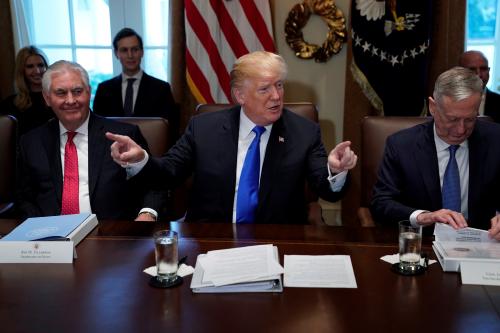Donald Trump’s erratic behavior will not get him removed under the 25th Amendment, full stop. Congressional Democrats including Sen. Elizabeth Warren (D-Mass.), progressive voters, and never-Trump Republicans have bought into a fallacy: that the 25th Amendment is an effective path to removal because of the long list of grievances against the president. It won’t happen because although the president can’t fire Congress, he can most certainly fire the Cabinet if they make the attempt.
What the 25th Amendment allows
Under Section IV of the 25th Amendment, the vice president and a majority of the cabinet can send a letter to the president pro-tempore of the Senate and the speaker of the House notifying them that the president is “unable to discharge the powers and duties of his office.” When that happens, the vice president will assume the role of “acting president” and the president is (temporarily) relieved of his duties. The president can notify congressional leadership that no incapacity exists and unless the vice president and the majority of the cabinet disagree, the president will reassume his duties. Otherwise, two-thirds of both houses of Congress would be required to vote to permanently bestow the title of “acting president” upon the vice president.
Incapacitation, not incompetence, is what it was designed to address
The 25th Amendment was intended to deal with a situation in which the president was incapacitated but still alive. Imagine a scenario in which the president has suffered a massive stroke. The stroke has put him in a persistent vegetative state. He is unable to discharge the office but, because he has not died, the vice president cannot assume the presidency in the normal manner. Prior to the passage of the 25th Amendment, there was no constitutional remedy for such a situation. Such a scenario is real—such a medical crisis happens to Americans every day—and if it afflicted a president, the stakes would be profound.
The intent of the 25th Amendment was not to remove presidential powers because people disagreed with the president or because they questioned his judgment. Some argue that President Trump’s behaviors and actions in office suggest that he is suffering from some mental defect or other psychological disorder that renders him “unable to discharge the powers and duties of his office.” However, the president’s physicians have not declared that to be true. People may disagree with the president, question his motives, or even question his competence in office, but short of a medical assessment saying otherwise, he is the individual whom Congress certified, by counting the electoral votes, is the duly elected president of the United States.
If the Cabinet tries it, Trump could fire them before it reaches Congress
If the vice president and a majority of the cabinet decided that there was something wrong with the president’s mental capacity to carry out his duties, could they remove him? Absolutely. But how, exactly would that work and what would be the stumbling blocks? There are many. First, such an effort by Vice President Mike Pence and a majority of the cabinet would have to be done in absolute secret. Whoever began such an effort would have to be completely certain that they had enough support, and could only approach individuals willing to sign on. If a cabinet official approached anyone not willing to sign a letter to congressional leadership to invoke the 25th Amendment, that person could—and likely would—notify the president. The president could then summarily begin firing whichever members of the cabinet were or were believed to be staging a 25th Amendment intervention. Because each member of the cabinet serves at the pleasure of the president, each can be fired for whatever reason the president desires.
Moreover, such an effort would require the signature of the vice president. If Mr. Pence believed that his ascension to the role of acting president was politically viable under such a circumstance, he would be fooling himself. The president’s support among voters would mean that Mr. Pence would be seen as a traitor who staged a coup for his own political advancement. Given that the Trump-Pence ticket was elected because of a combination of fewer than 80,000 votes spread among three states in 2016, it is hard to imagine that he would be viable to seek his own term in the upcoming presidential election.
Even if Mr. Pence and a majority of the cabinet were able to stage such an intervention, Congress would have to sustain it with a two-thirds vote in both chambers—something I have noted before is a standard higher than impeachment and removal. Assuming all Congressional Democrats voted to remove the president from office permanently, 18 Republican senators and 98 Republican House members would have to sign on—an outcome that would be just as politically damaging to them as it would be to Mr. Pence.
Politics does not make for a scenario in which President Trump—in his current situation—would be removed under the 25th Amendment. The president can combat it in exactly the same way he built his celebrity persona: by firing people.
What can be done with an erratic president?
Ultimately, the separation of powers within the Constitution allows for a manner to remove a president from office because his behavior is so erratic that it threatens the Republic and/or the safety and security of the United States. That move would be impeachment. The official standard for impeachment involves the commission of “high crimes and misdemeanors.” However, impeachment is a political process. Congress can impeach and remove a president for whatever reason they desire and there is no check on that power.
What’s more, impeachment and removal require a lower standard than removal under the 25th Amendment: a simple majority in the House of Representatives and a two-thirds majority in the U.S. Senate. The president cannot summarily dismiss members of the legislative branch, thus protecting the impeachment process from presidential intervention in ways the 25th Amendment is not. If Congress is so terrified that the president’s mental health or psychological state is a threat to the country, members should convince their colleagues as such and take that argument to the people.
However, the political reality is far different. Political support for Mr. Trump would affect Congressional Republicans in the same way it would affect Vice President Pence. What President Trump would label a coup—on Twitter, in real time—would give way to an understanding among his most ardent supporters that Republicans were complicit in his removal. Mr. Trump would spare no one from his criticism, and Republican elected officials know this. No matter how disastrous they may view the president (although I assume most do not), their own political futures are intimately tied to his.
Removal under the 25th Amendment is currently not a real option; impeachment and removal isn’t either. Neither is it likely to be an option after the midterms. No matter how many people are appalled by the president’s behaviors, actions, and policy choices, it’s Congress that would have to act. Without the votes, and barring a drastic change in politics or the president’s physical health, he’s going to be president until at least January 20, 2021.










Commentary
How Donald Trump could tweet his way out of a 25th Amendment challenge
September 7, 2018